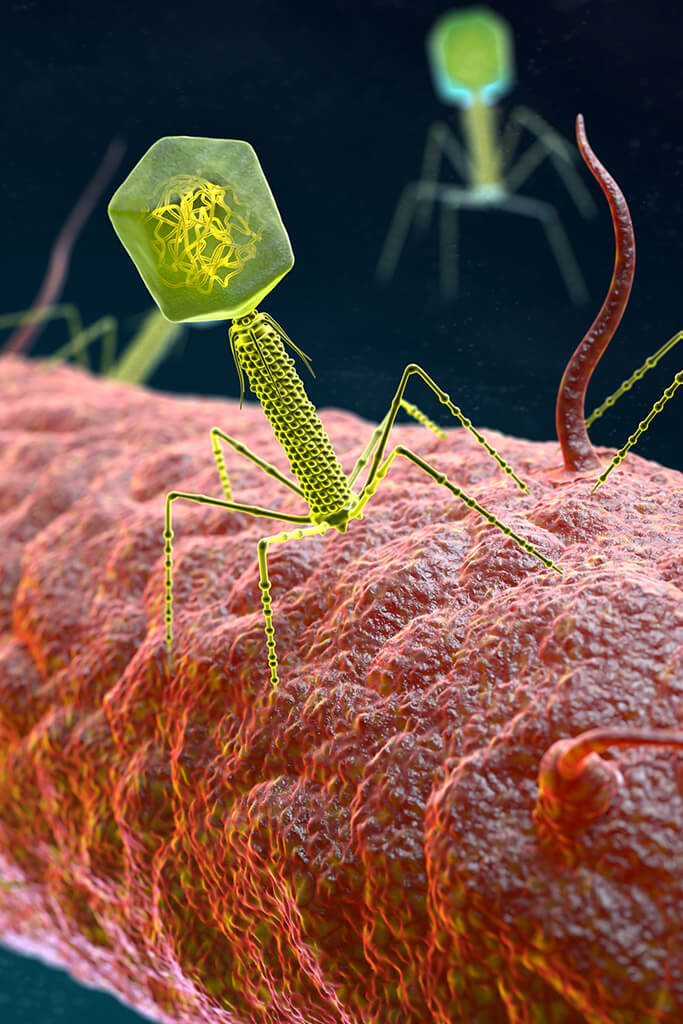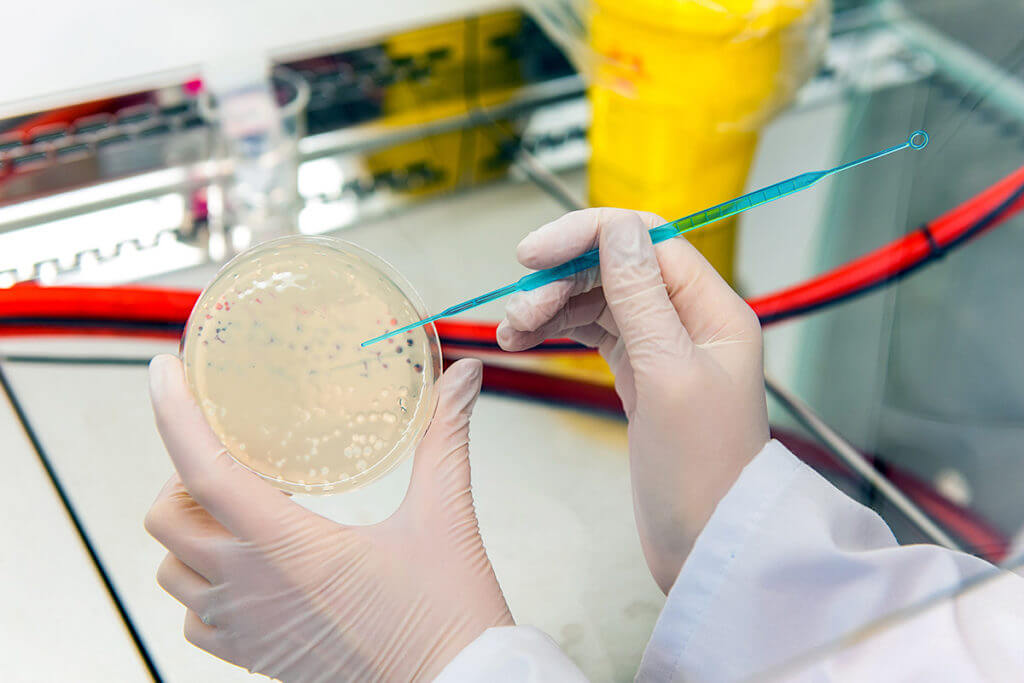Phages are becoming increasingly important in modern medicine. After almost falling into oblivion due to antibiotics, they are currently experiencing a comeback.
This is not least due to the steady rise in multi-resistant germs. Bacteriophages represent a gentle therapeutic approach in Eastern Europe, as they have a self-regulating effect without leaving any traces or side effects.
Phage therapy is interesting for people for whom the classic drug approach no longer helps. Medical use is not authorized in the EU except in Belgium. In the case of skin diseases or to strengthen the skin flora bacteriophages may be used externally.
However, treatments with bacteriophages are currently only being carried out in Georgia, Russia and Ukraine.
You can find out how this works, what exactly bacteriophages are, how they work and how they are used on the following page.


Translated from Greek, bacteriophages mean “bacteria eaters“. This name is no coincidence.
Phages are viruses that specialize in destroying bacterial cells. Bacteriophages, as they are called in English, first infect the malignant bacteria before multiplying in them.
However, the process involved is much more complicated than this brief description might suggest.
In principle, bacteriophages, or simply phages for short, are used wherever the right bacterium can be found. They only infect strains within a bacterial species without crossing species boundaries.
Just like bacteria, bacteriophages are subject to constant evolution and continue to develop together with them.
As a result, they are always one step ahead of the bacteria and remain effective. In contrast, bacteria are becoming increasingly resistant to antibiotics.
With the increase in multi-resistant germs in medicine, phages are also playing an increasingly important role.
While no significant side effects are known, some phages also penetrate biofilms better than pharmaceutically produced antibiotics.
The Canadian biologist and microbiologist Félix Hubert d’Hérelle, who was born in Paris, is generally regarded as the discoverer of bacteriophages.
He was also the one who gave the so-called “bacteria eaters” their name, which is still used today. As early as 1919, he successfully treated a patient with bacteriophages for the first time.
Today, Georgia is one of the pioneers in phage technology with the Georgi-Eliava Institute.
The institute is named after Georgi Eliava. He maintained close contact with d’Hérelle and founded the research facility as a bacteriology laboratory in 1923.
In the USA, the Eli Lilly Company was already on the market in the 1940s with seven different phage products for use on humans.
However, the first antibiotics were available in Europe and the USA at the same time. As a result, phage therapy quickly became uninteresting.
This is only now gradually changing again. There are hardly any new additions to the antibiotic arsenal and more and more bacteria are resistant to existing active substances.
Research does not stand still and new and more effective drugs and therapies are constantly coming onto the market.
At the same time, however, many bacteria are becoming increasingly resistant. Multi-resistant germs are often known as “hospital germs” and can have fatal consequences for a patient’s health.


Phages differ according to the structure of their genome and are classified into different groups.
Even though they can differ considerably in shape and size, they are similar in the way they develop by means of reproduction. Lacking their own metabolism for reproduction, they require a suitable, living bacterial cell as a host.
Reproduction is more or less the same for all forms. It begins with the attachment of bacteriophages to the bacterial surface. The phage introduces its genetic material into the bacterium.
The production of new phages now begins inside the bacterium. As soon as the production of the new bacteriophages is complete, the bacterium’s envelope dissolves (lysis) and is thus destroyed. The unenveloped released phages start a new process.
As already mentioned, there are different groups or families of phages. They are classified taxonomically according to their morphology, their genome and their host.
A distinction is made between DNA phages with single-stranded DNA, known as ssDNA phages, and those with double-stranded DNA, known as dsDNA phages.
More than 6000 different bacteriophages are now known. For example, there are the temperate phages.

The caudovirales are probably the largest group. They can be recognized by their tail, which is up to 230 nm long and hangs from the icosahedral head.
The linear double-stranded DNA genome is located in the head. Within the Caudovirales, different phage families can be categorized, which have slightly different infection pathways in the bacteria.
Several of a set of available phages may prove suitable for a bacterial pathogen.
In terms of therapy with bacteriophages, the aim is therefore to use mixtures of different phages and exploit their synergistic effect.
At the same time, the resulting bacterial phage resistance can be reduced.
The bacterial resistance of bacteriophages is an important aspect. However, other properties are also taken into account when selecting a suitable therapy with phages.
Phages consist of genetic material and a protein coat. As a result, they cannot reproduce without a host cell.
However, once they have found a suitable host cell, they induce it to multiply the phage genetic material. After the decay or bursting of the bacterium, the genetic material is released.
They are considered biological weapons against bacteria and an effective alternative to antibiotics. As bacteriophages can be used in many different ways, they are currently being tested for their efficacy in various clinical studies.
For example, a German research project has set itself the goal of establishing bacteriophages as an approved drug against bacterial infections or infectious diseases.
“Phage4Cure” was initiated by the Charité in Berlin because resistance to antibiotics is increasing worldwide. 1
For this purpose, they are bred in the laboratory according to their respective area of application. They are then mixed into a cocktail based on a recipe for the respective application.
A distinction is made between a personalized approach and a fixed formulation of several phages.
Especially in hospitals, multi-resistant germs or hospital germs (e.g. Acinetobacter Baumannii or Pseudomonas Aeruginosa) often lead to complications in patients.


In theory, phages can be used for therapy wherever bacteria need to be killed. In the countries of the European Union, medicinal use is currently only permitted in Belgium. There they are taken orally or injected.
Phages are primarily used for skin diseases or to strengthen the skin flora. The bacteriophages are applied externally. The naturally occurring phages are concentrated in the form of sprays.
In this way, their effect can be used to strengthen the balance of the skin flora.
Sprays with concentrated bacteriophages are currently available for use in the following skin diseases:
This type of phage application is a natural and gentle way of tackling chronic dermatological diseases.
SKINCARE PROTECT
Probiotic skin protection SkinCare Protect with Phage Technology.
Your skin comes to rest.
This current documentary by Bayerischer Rundfunk shows how phages can help with diseases. Tonja suffers from cystic fibrosis, a hereditary disease in which the metabolic function is defective.
The woman is also affected by a multi-resistant germ in her lungs. This means that no antibiotic can help her fight this germ.
The last resort for Tonja before the lung transplant is phage therapy. However, this is not approved in the EU.